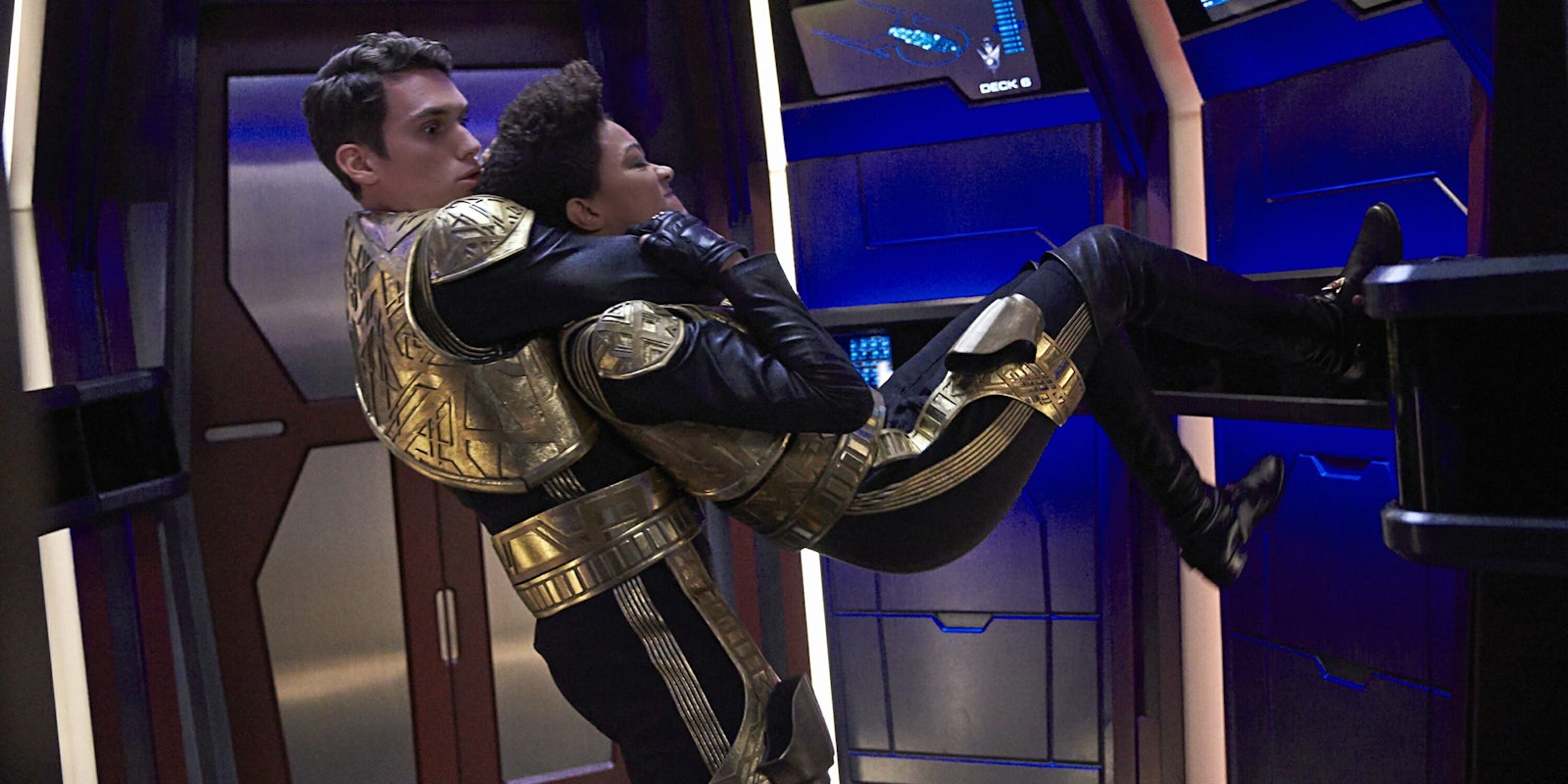Star Trek: Discovery heralds a new era for Star Trek costume design, updating the uniforms and completely rebooting the Klingon aesthetic.
Gersha Phillips is the lead costume designer on Discovery, taking over from Suttira Larlarb (American Gods). Larlarb worked on the show’s earlier stages with former showrunner Bryan Fuller, who envisioned a uniform inspired by Star Trek’s original 1960s series. In the end, Discovery wound up with a more sleek and high-tech look. The new uniforms follow the classic idea of color-coded Starfleet departments (gold, silver and bronze accents for Command, Science, and Operations), but also take inspiration from contemporary athleisure brands.
Speaking to Gersha Phillips, we delved into Discovery’s fashion influences from Alien to Balenciaga. She’s a fount of knowledge about the canon background for costuming details like Klingon armor (Klingons have different internal organs!), and cosplayers have her to thank for the Mirror Universe’s beautiful gold capes.
To start with, I’d love to know how the new uniforms were influenced by previous Star Trek costumes, and whether there was anything you tried to avoid.
I wasn’t the first designer who worked on them, so I’m not sure what the mandate was from Bryan Fuller for those [earlier] ones. When I took over, our mandate was to do something that felt real. There was a lot of talk of looking at Ripley from Alien. This idea of grounding something in reality, and still honest to the Starfleet look and feel.
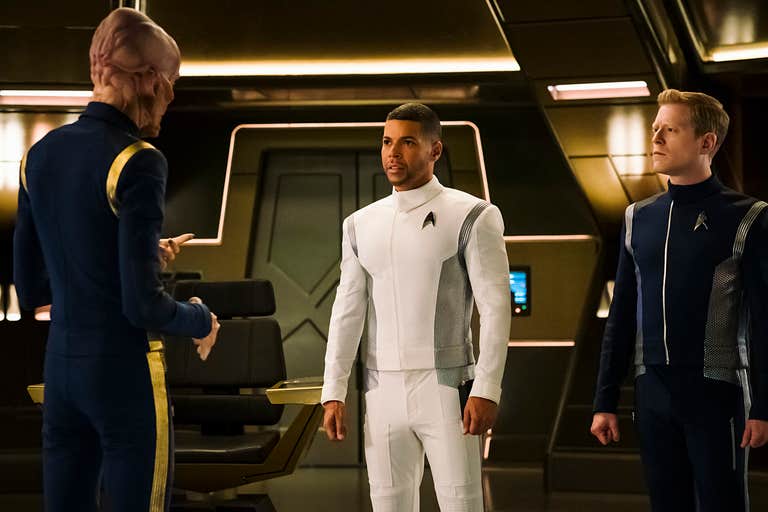
This felt like the first Star Trek where there was this practical aspect, like the armor. The Starfleet officers have a tactical breastplate.
The idea was it had some lifesaving capacity. It would be bulletproof, blade-proof—depending on what the blade was made of, obviously. They would have smart technology. So the compression panels, which are the lines on the shoulders and that go down the body, have body-monitoring components. It would also have some sort of life-protection qualities. What that was, we never really figured out, but that was the idea behind adding those elements to the costumes.
One of the unusual aspects of working on this show is that everyone has to wear the same clothes in every episode. Usually, there are characterization considerations. What was it like to be designing from that perspective?
At the beginning, I thought it was going to be really easy. But I think because our costumes are so tailor-fit, it really becomes like individual costumes. The idea is that your body would be 3D scanned, and then the items are printed for you. They’re made exactly to your measurements. But that in itself just adds a lot more work. Everybody’s costume is basically custom-fit. And also within that, we have special undergarments. It’s a lot harder than I thought it would be. But then we also added things like Starfleet pajamas, we have the Disco jogging look, we had some party scenes, some casual scenes that we’ve done as well.
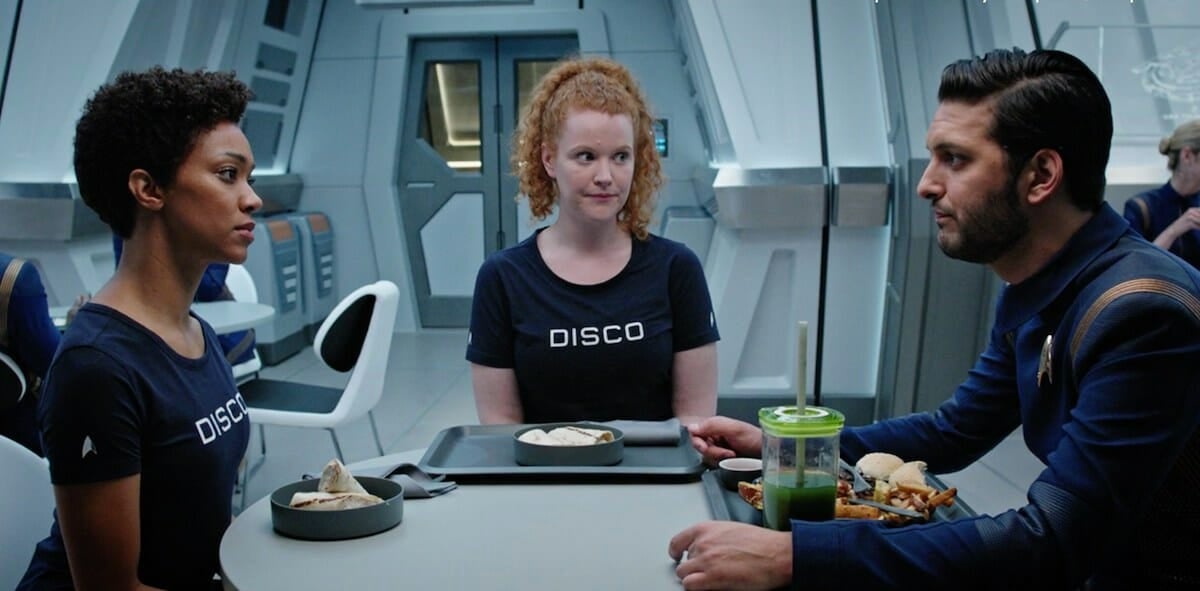
For the party scene, how did you think about the idea of futuristic fashion? It’s always interesting to see how each Star Trek embraces the idea of what the future will look like.
We’re in the year 2259, which is like 240 years in the future, so I try to push the look as far as I can with the time and the resources available. We have 10 days to prep an episode, and we may know about something a little bit in advance, but it’s not always enough time to develop a whole new set of costumes. So for that, there’s some really interesting designers that are designing things that are a little more advanced and have a bit of a futuristic take on them. There’s a certain kind of seaming and construction technique that I look for, that I feel signifies the future. The fabric choices, things like that. I feel like a lot of sportswear brands like Adidas, Nike, Y-3, Lululemon, these brands are all doing really interesting things with construction.
I love the idea that people are wearing Lululemon in the future, in space.
There actually is quite a lot of them! And I actually stole building techniques from them, for building other things. It’s really interesting, you know, the bonding, which is my favorite thing about Lululemon, where they’re bonding everything as opposed to sewing.
Is that kind of like gluing the seams?
Yeah, they use a heat press machine.
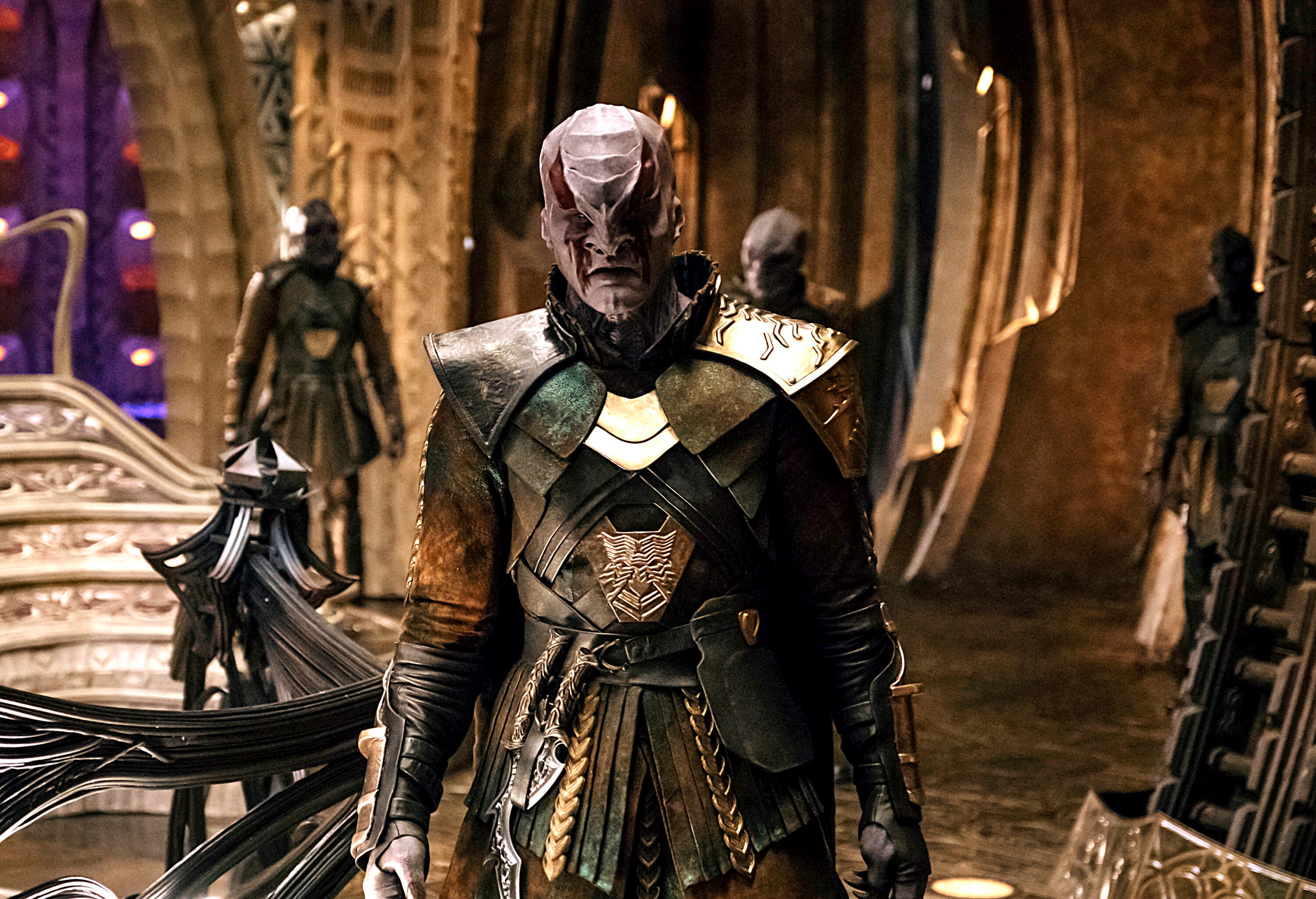
So, to move onto the Klingons, it’s a very different aesthetic from Starfleet, and I think one of the coolest visual aspects of the show. How did you go about this brand new look for the Klingons? I’m assuming you were collaborating with the production designer because there are so many set design elements playing into that as well.
This is another part where Suttirat [Larlarb] was on the original Klingon costumes. If you look at T’Kuvma and the house of T’Kuvma, which is the first set of Klingons we see in the beginning… the idea behind that was, she was looking at conquistadors, and other sorts of armor that we could replicate. The other thing we were trying to do in the beginning was: What does a klingon body look like? The idea that they have double organs. So we sort of expanded the body and extended the breastbone, so it looked like there was two of everything there. Just to make it less human-like, that was the mandate for the whole aesthetic on this one.
One of the things we were doing when we were building them was looking for different fabrics. We used a lot of leather and then molded texture onto the leather. That’s what creates all the sculpture pieces that you see for the armor. And also the footwear, the boots are hoof-toe boots, that’s another thing that came from Bryan [Fuller]. Which actually is funny because J.J. Abrams uses that on the Romulans in the first Star Trek he did.
I think the main thing is to create a species that doesn’t have so many human components, as opposed to how they were in other iterations of Star Trek. Trying to camouflage as much of the human body as possible.
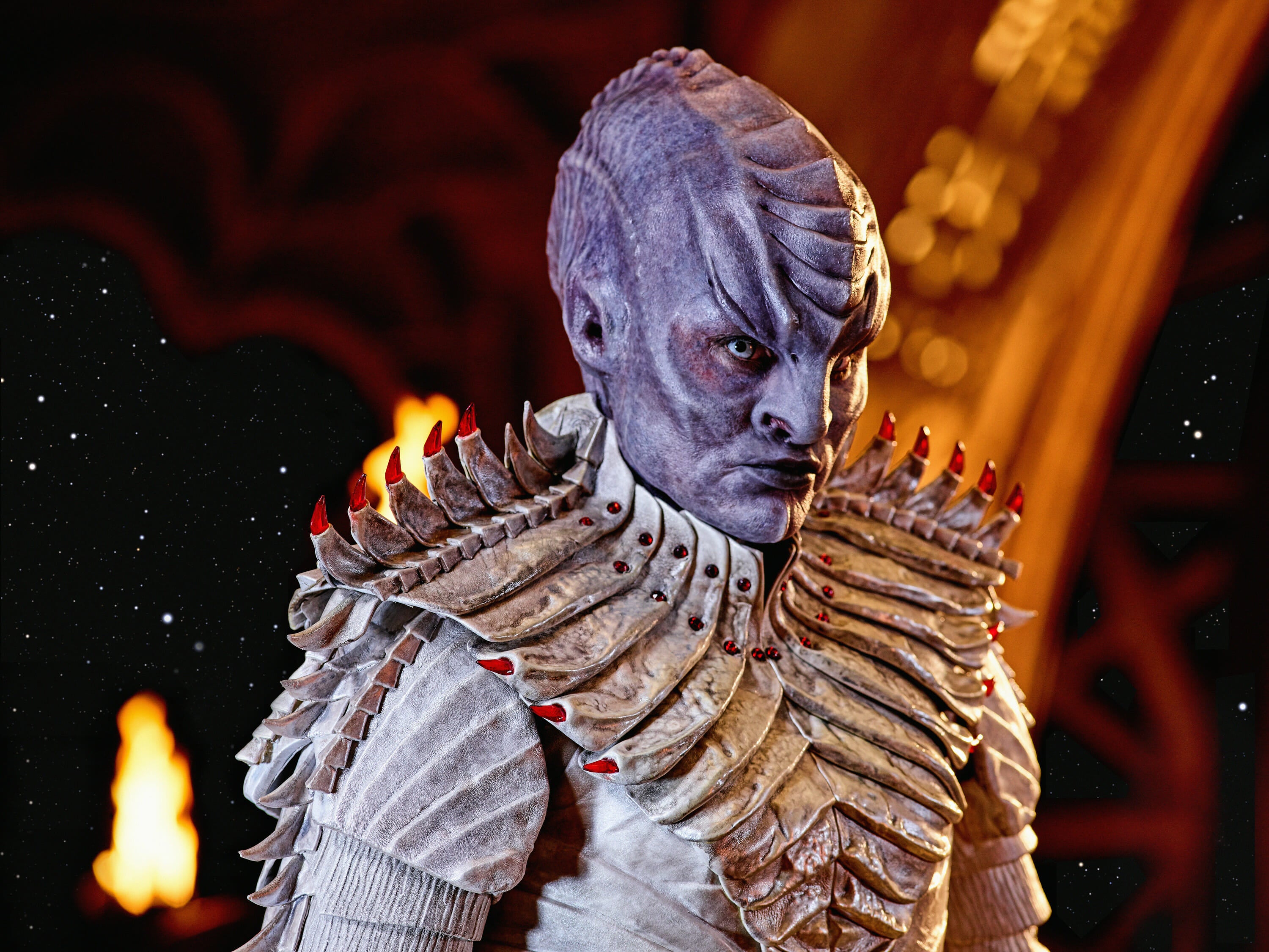
It definitely seems like you can see the progression through this series, like we’ve now reached a point where we have the technology to make them look like actual aliens.
Yeah, exactly. The costumes and CGI, I feel like they even wanted to do more with eyes and things like that, but were limited by how much screentime they had. I’m really proud of what we did, I think they look amazing. They’re definitely an improvement on other iterations of Klingons. And I think the fans are getting onboard with it. L’Rell’s become such a loved character, and such a strong icon, that I feel like they’re accepting her.
So are there any little details in the Klingon outfits that people should look out for, like differences between the Klingon houses?
Yes, there’s definitely differences between the houses. I feel like the House of Kor are a little bit more… savage is the wrong word, but they were a little less refined. And then we had Dennas, which we did as the girl Klingon house, the one that’s got all the facial jewelry on her. We added some fur elements, and we were playing a lot with armor. If you look at the house of Mo’Kai, the house of spies, the house that L’Rell shares with T’Kuvma’s house… she has a little duality. We added a house of Mo’Kai emblem to her later on, in episode 5 or 6.
Next, I’d like to talk about the Mirror Universe. I was excited to see those gold capes show up, and it’s interesting to see how it overlaps with the uniforms in the original series. Could you tell me about the design process for that?
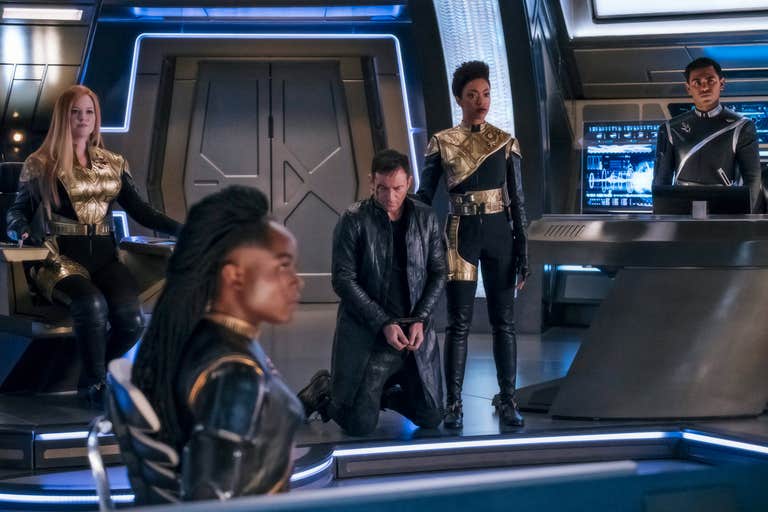
I spent a lot of time watching [Original Series episode] “Mirror, Mirror” and just really enjoying those costumes, and extrapolating from that. Definitely, the idea of the asymmetrical-ness of those chestplates was like a take on “Mirror, Mirror.” The main thing the producers said to me was, they need to be ready to protect themselves. They’re armored all the time and they’re always armed, because in order to move up, you kill your predecessor. So you’re always ready for a fight or a takedown. We were looking at our tactical vests and thinking, well, what can we do with that sort of idea?
The patterning came from Tamara [Deverell] our production designer. She kept talking about brutalist architecture and design, and also when I was talking to my illustrator, the image we were looking at had sort of filigree workings on the armor. We were talking about what would give us that kind of brutalist feel, and we started looking at art deco images, and that’s where that design came from.
We started with our original uniform as the base because, you know, it’s a mirror. And then make it black, which gives you the darker side. There was one costume that we didn’t use, we were going to do red as medical, which would’ve been kinda cool.

We had to create different levels. We had the emperor, the captain’s level… and the other thing we thought we’d try was the dress, which turned out really great, but pairing it with pants and boot pants, which I kind of got from Balenciaga. That’s what the girls wear, we found thigh-high boots and added a pair of shorts to them, and underneath their dress they put the boot pants on that look like leather leggings.
I just realized I haven’t asked you about Vulcans yet!
Those are my favorites, actually, because that’s the one I did from the very beginning. I started the Vulcans and I did them all the way through. Again, Bryan’s mandate for that, he just wanted them to be really beautiful and elegant. He loves Alexander McQueen, so that’s where I started, with the shoulders and the collars. Some of those pieces are definitely inspired by McQueen.
The only character in the show whose dress sense we actually know is Sarek, because he’s the only one not wearing a uniform. I enjoyed the buttoned-up appearance for him.
James is wonderful, he wears it so well. James Frain and Wilson Cruz in his white doctor’s uniform, they were my favorite characters, they both wore their costumes so beautifully.
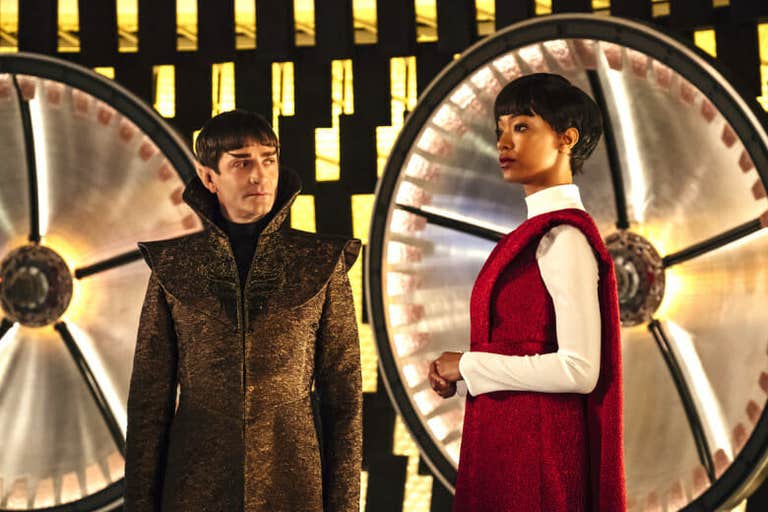
Finally, do you have any particular favorites from earlier in the Star Trek franchise? And is there’s anything you’d like to include in future seasons?
There’s definitely some I’d like to pay homage to, for sure. There’s such a wealth of costumes to choose from. I think Jeri Ryan’s Seven of Nine costume is fabulous, I was looking at that the other day and thinking how cool that was. Actually, the picture we have up in our office… we used it as “What not to do,” but I actually really love it. I think they’re from The Wrath of Khan or the original movie. Like the mauve-colored, two-piece… it’s quite a funny picture but I kind of love it, just in terms of fashion I think it’s great.
When you think of TOS… I still think they’re great costumes, I just don’t think they resonate anymore, and they don’t resonate in 2259. But definitely they were great in 1960, if you know what I mean? I also love the Enterprise jumpsuit. I know a lot of people don’t like it, but I just find them really real and grounded in reality. You know, the idea that the Enterprise and Starfleet is an exploratory business, I like the idea that they wear almost like a naval uniform or a NASA uniform.
It’s tricky because it’s always trying to blend the futuristic with the practical, so that it feels real. A lot of movies use certain things that become signifiers of the future. The Nehru collar, for instance, is something that a lot of futuristic films adopted, and it’s something that was set up in the ’60s and early ’70s when sci-fi became popular. It’s almost like they forgot that collars existed. It seems to be such a strong signifier for the future.

